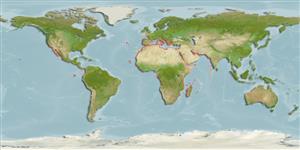Common names from other countries
Environment: milieu / climate zone / depth range / distribution range
Ekologi
; payau; kisaran kedalaman 0 - 2 m (Ref. 80843). Tropical, preferred 23°C (Ref. 107945); 52°N - 35°S, 123°W - 75°E
Circumglobal.
Length at first maturity / Size / Weight / umur
Maturity: Lm ? range ? - ? cm Max length : 1.5 cm TL jantan/; (Ref. 101378)
Inhabits extreme environments such as salt lakes or brine waters, coastal or inland (Ref. 105262), just like saline lakes, and coastal salterns (Ref. 105501). Its nauplii is an irreplaceable live feed for marine and shrimp larvae. Latent eggs cysts are known to withstand long drought periods at severe hypersalinity (Ref. 105261). In an experiment, adults are fed with the dinoflagellate Gyrodinium corsicum and Cryptophyta Rhodomonas baltica (Ref. 105262).
Life cycle and mating behavior
Kematangan | Reproduksi, perkembang biakan | Pemijahan | telur-telur | Fecundity | Larva
Reproduction mode may be oviparous or oviviparous, depending on environmental conditions. Copulation is present. Life cycle: Eggs may either develop into nauplia (larvae) or may stay as cysts (dormant) to survive the drought period before hatching into nauplia.
rujukan utama
Acuan | Koordinator | mitra
Bisby, F.A., M.A. Ruggiero, K.L. Wilson, M. Cachuela-Palacio, S.W. Kimani, Y.R. Roskov, A. Soulier-Perkins and J. van Hertum. 2005. (Ref. 19)
Status IUCN Red List (Ref. 130435)
status CITES (Ref. 108899)
Not Evaluated
Not Evaluated
penggunaan manusia
Perikanan: komersial; Budidaya air: komersial
FAO - Budidaya air: production; Perikanan: landings | FishSource | Sea Around Us
Alat, peralatan
informasi lanjut
Umur / SaizPertumbuhanpanjang-beratpanjang-panjangMorfologiLarvaKelimpahan
Sumber internet
Estimates based on models
kategori harga
Unknown.
